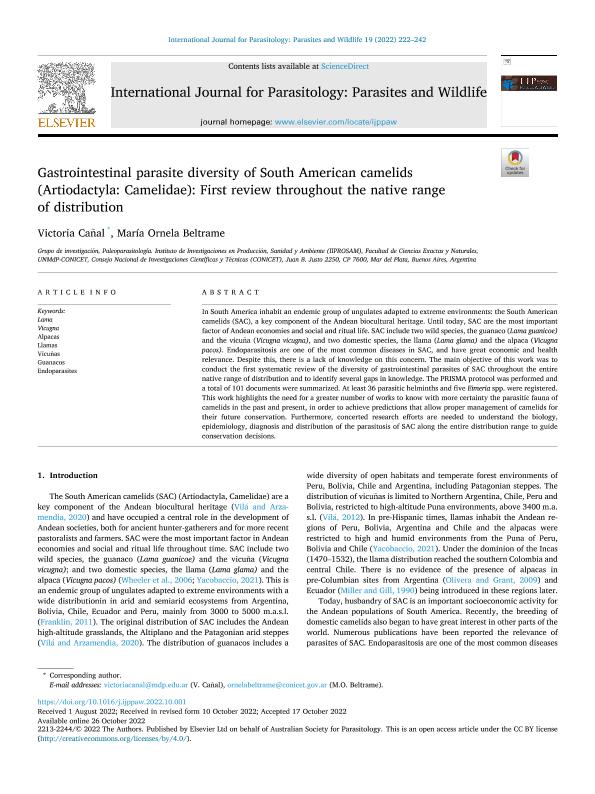Artículo
Gastrointestinal parasite diversity of South American camelids (Artiodactyla: Camelidae): First review throughout the native range of distribution
Fecha de publicación:
11/2022
Editorial:
Elsevier
Revista:
International Journal for Parasitology: Parasites and Wildlife
ISSN:
2213-2244
Idioma:
Inglés
Tipo de recurso:
Artículo publicado
Clasificación temática:
Resumen
In South America inhabit an endemic group of ungulates adapted to extreme environments: the South American camelids (SAC), a key component of the Andean biocultural heritage. Until today, SAC are the most important factor of Andean economies and social and ritual life. SAC include two wild species, the guanaco (Lama guanicoe) and the vicuña (Vicugna vicugna), and two domestic species, the llama (Lama glama) and the alpaca (Vicugna pacos). Endoparasitosis are one of the most common diseases in SAC, and have great economic and health relevance. Despite this, there is a lack of knowledge on this concern. The main objective of this work was to conduct the first systematic review of the diversity of gastrointestinal parasites of SAC throughout the entire native range of distribution and to identify several gaps in knowledge. The PRISMA protocol was performed and a total of 101 documents were summarized. At least 36 parasitic helminths and five Eimeria spp. were registered. This work highlights the need for a greater number of works to know with more certainty the parasitic fauna of camelids in the past and present, in order to achieve predictions that allow proper management of camelids for their future conservation. Furthermore, concerted research efforts are needed to understand the biology, epidemiology, diagnosis and distribution of the parasitosis of SAC along the entire distribution range to guide conservation decisions.
Palabras clave:
ALPACAS
,
ENDOPARASITES
,
GUANACOS
,
LAMA
,
LLAMAS
,
VICUGNA
,
VICUÑAS
Archivos asociados
Licencia
Identificadores
Colecciones
Articulos (IIPROSAM)
Articulos de INSTITUTO DE INVESTIGACIONES EN PRODUCCION, SANIDAD Y AMBIENTE
Articulos de INSTITUTO DE INVESTIGACIONES EN PRODUCCION, SANIDAD Y AMBIENTE
Citación
Cañal, Victoria; Beltrame, Maria Ornela; Gastrointestinal parasite diversity of South American camelids (Artiodactyla: Camelidae): First review throughout the native range of distribution; Elsevier; International Journal for Parasitology: Parasites and Wildlife; 19; 11-2022; 222-242
Compartir
Altmétricas




